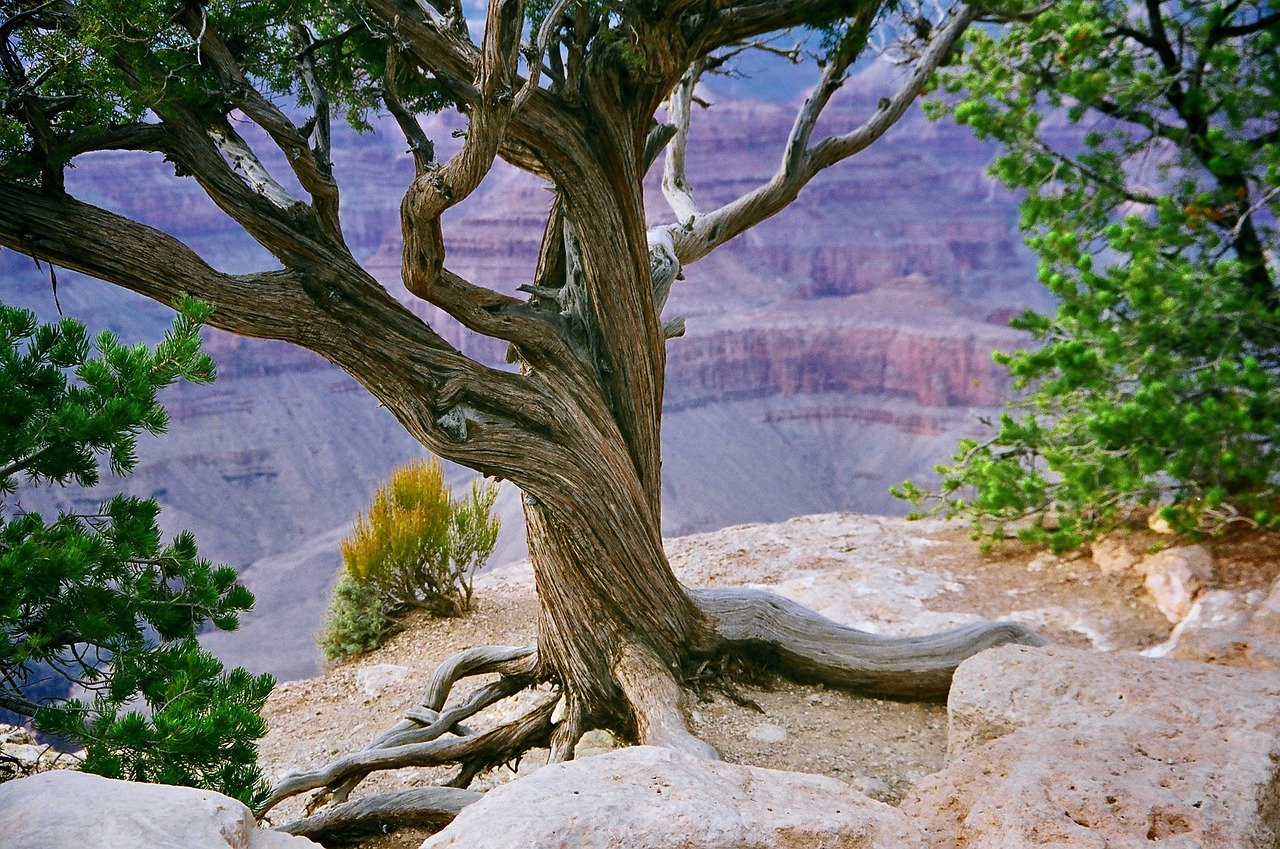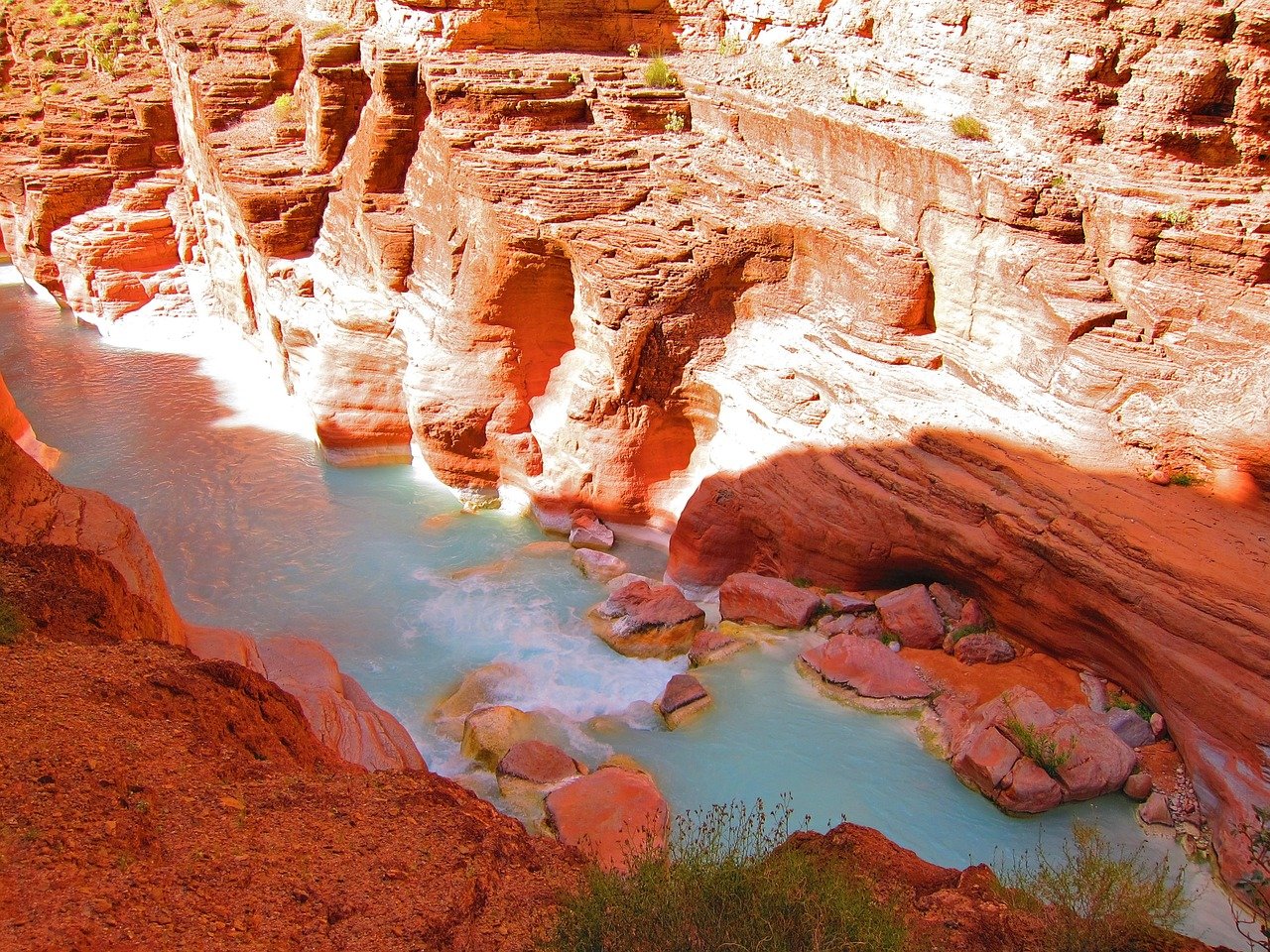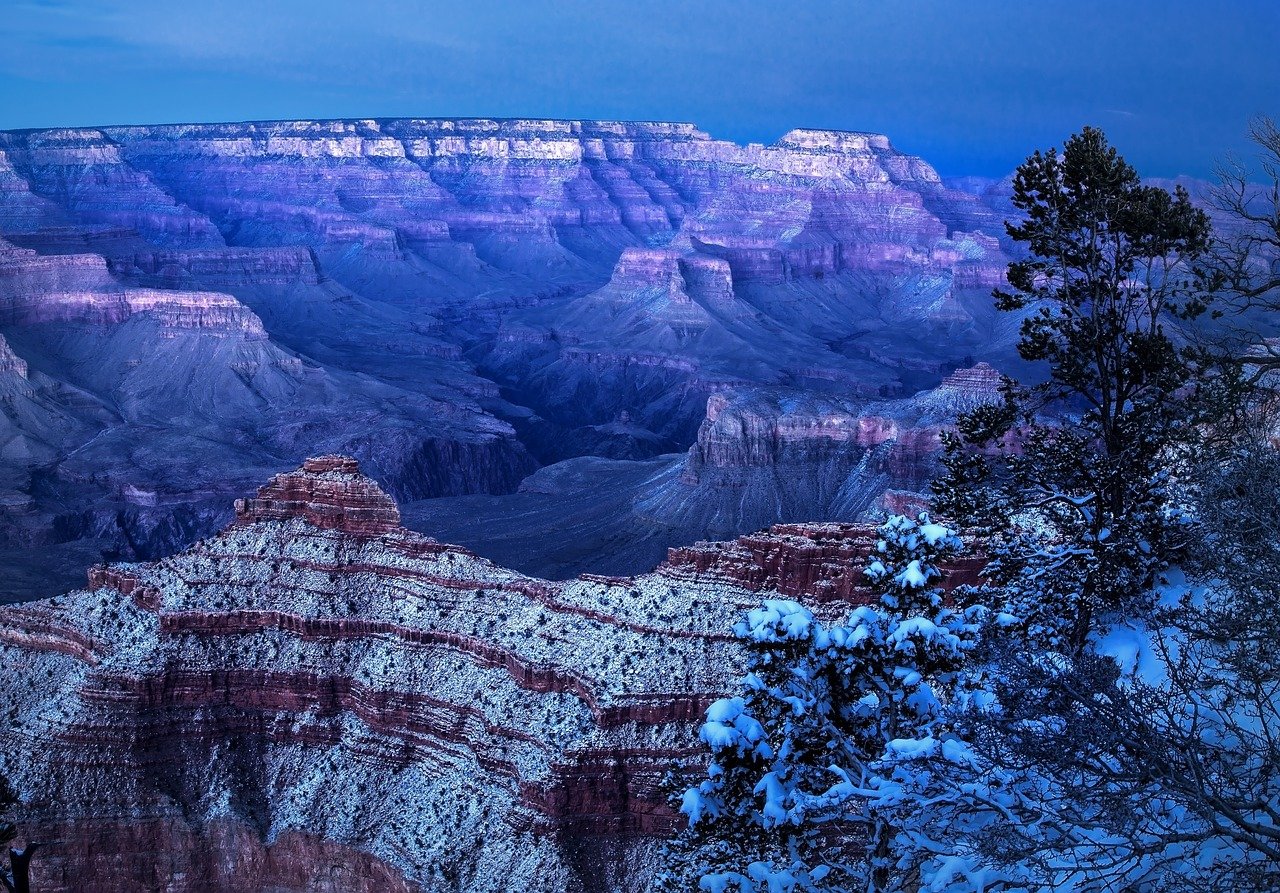Introduction to the Grand Canyon
The Grand Canyon, a monumental natural wonder located in the northern part of the U.S. state of Arizona, is renowned for its immense size and intricate, colorful landscape. Spanning approximately 277 miles in length, up to 18 miles in width, and over a mile deep, this awe-inspiring geological formation is the result of millions of years of erosion primarily by the Colorado River. The Grand Canyon’s vast expanse and striking beauty draw millions of visitors from around the world each year, making it one of the most visited national parks in the United States.
The origins of the Grand Canyon date back over 5 million years, with its formation being a testament to the powerful forces of nature. The Colorado River, which continues to carve its way through the canyon, has exposed nearly two billion years of Earth’s geological history through its layered rock formations. These layers reveal a complex and fascinating story of ancient seas, rivers, and volcanic activity, offering a glimpse into the planet’s dynamic past.
Beyond its geological significance, the Grand Canyon holds a deep cultural and historical importance. It has been home to Native American tribes for thousands of years, who have revered it as a sacred site. Various tribes, including the Havasupai, Hopi, Hualapai, Navajo, and Paiute, have left their mark on the region through ancient dwellings, petroglyphs, and oral traditions that convey their spiritual connection to the land.
As we delve deeper into the Grand Canyon’s cultural and historical significance, it becomes evident that this natural marvel is more than just a breathtaking landscape. It is a living museum, preserving the stories of both the Earth and its early inhabitants. This introduction sets the stage for a comprehensive exploration of the Grand Canyon’s multifaceted legacy, allowing us to appreciate its full grandeur and the profound impact it has had on natural history and human culture alike.
Geological History and Formation
The Grand Canyon, an iconic symbol of natural beauty and geological wonder, owes its formation to a series of complex geological processes that have unfolded over millions of years. Central to its creation is the Colorado River, which has carved its way through layers of rock, creating the vast chasm we see today. The river’s relentless erosion, coupled with tectonic activity, has exposed a rich tapestry of geological history, offering a window into the Earth’s past.
The canyon’s rock layers tell a story that spans nearly two billion years. At the base lies the Vishnu Basement Rocks, composed primarily of metamorphic and igneous formations. These ancient rocks provide insight into the early geological activities that shaped the region. Above them, the sedimentary layers, including the Grand Canyon Supergroup, capture a more recent history, showcasing the deposition of sediments in various environments, from shallow seas to desert landscapes.
The formation of the Grand Canyon began in earnest around five to six million years ago, a relatively recent event in geological terms. The uplift of the Colorado Plateau played a crucial role in this process. As the plateau rose, the Colorado River’s gradient increased, accelerating its erosive power. This uplift, combined with the river’s meandering course, led to the incision of the deep and expansive canyon.
The rock layers in the Grand Canyon each represent different geological periods, with the oldest rocks at the bottom and the youngest at the top. The Kaibab Limestone, for instance, forms the canyon’s rim and dates back approximately 270 million years. The intricate interplay between erosion, sedimentation, and tectonic forces has resulted in a landscape that is not only visually stunning but also of immense scientific value.
Understanding the geological history and formation of the Grand Canyon enhances our appreciation of this natural wonder. It reveals the dynamic processes that shape our planet and underscores the significance of geological time in shaping the Earth’s surface. The Grand Canyon stands as a testament to the power of nature and the passage of time, offering a profound connection to the Earth’s ancient past.

Native American Heritage
The Grand Canyon holds profound cultural and historical significance for various Native American tribes, including the Havasupai, Hopi, and Navajo. These tribes have inhabited the region for centuries, developing a deep connection with the land that is reflected in their cultural practices, myths, and traditions.
The Havasupai, known as the “People of the Blue-Green Waters,” have lived in the Grand Canyon for over 800 years. They inhabit the Havasu Creek area and are renowned for their intricate basketry and vibrant, turquoise-colored jewelry. The canyon’s natural beauty is interwoven with their spiritual beliefs, emphasizing the symbiotic relationship between the people and their environment.
Similarly, the Hopi tribe has a long-standing presence in the region. For the Hopi, the Grand Canyon is not just a geographical feature but a sacred place embedded in their origin stories. According to Hopi legends, the canyon is the site where their ancestors emerged into the present world. This spiritual connection is evident in their ceremonies, rituals, and oral traditions that have been passed down through generations.
The Navajo, or Diné, also regard the Grand Canyon as a vital part of their cultural heritage. The canyon is central to many Navajo myths and is considered a place of emergence, where the Holy People brought the Navajo into the world. This deep-rooted reverence is expressed through their sand paintings, chants, and stories that depict the canyon as a living entity.
Today, these tribes continue to maintain a strong relationship with the Grand Canyon, actively participating in its stewardship and preservation. Collaborative efforts between Native American tribes and government agencies aim to protect the canyon’s ecological and cultural integrity. Such initiatives ensure that the Grand Canyon remains a sacred and sustainable landmark for future generations, honoring its rich Native American heritage.
European Exploration and Settlement
The Grand Canyon, one of the natural wonders of the world, holds a rich tapestry of history that includes significant European exploration and settlement. The initial European encounter with the Grand Canyon occurred in 1540 when García López de Cárdenas, a Spanish explorer, ventured into the region under the command of Francisco Vázquez de Coronado. Cárdenas’s expedition marked the first recorded European sighting of the Grand Canyon, although the explorers were unable to find a route down to the Colorado River.
Nearly three centuries later, the Grand Canyon drew the attention of another notable figure, John Wesley Powell. In 1869, Powell led the first scientific expedition down the Colorado River through the Grand Canyon, meticulously documenting the geology, flora, and fauna of this awe-inspiring landscape. Powell’s expedition significantly contributed to the scientific community’s understanding of the region and laid the groundwork for future explorations.
The arrival of Europeans had profound impacts on the indigenous populations who had called the Grand Canyon home for millennia. Tribes such as the Havasupai, Hualapai, Hopi, and Navajo found their lives disrupted by the influx of settlers, traders, and explorers. European settlement often led to the displacement of these indigenous communities, fundamentally altering their traditional ways of life and leading to conflicts over land and resources.
European exploration and subsequent settlement in the Grand Canyon area sparked a series of historical developments that shaped the region’s trajectory. The establishment of mining operations, tourism, and eventually, the designation of the Grand Canyon as a National Park in 1919, all stem from the initial European interest. These developments not only transformed the region economically but also underscored the significance of preserving the natural and cultural heritage of the Grand Canyon.

The Grand Canyon in American Culture
The Grand Canyon holds a special place in American culture, symbolizing both the nation’s natural beauty and its pioneering spirit. Throughout history, it has been a source of inspiration across various forms of media including literature, art, music, and film. The canyon’s majestic landscapes and profound depth have captured the imaginations of countless artists and creators, making it a recurring motif in American culture.
In literature, the Grand Canyon has been a backdrop for numerous novels and travelogues. Writers like John Wesley Powell, who was one of the first explorers to navigate the Colorado River through the canyon, have chronicled its grandeur and complexity. His works, along with those of other authors, have contributed to the canyon’s mythos, portraying it as a place of adventure and discovery. Additionally, the Grand Canyon often symbolizes the untamed beauty of the American West in various literary works.
Artists have also been captivated by the Grand Canyon’s splendor. Renowned painters such as Thomas Moran and Albert Bierstadt have created iconic images that showcase its vivid colors and striking formations. These artistic depictions have played a significant role in promoting the Grand Canyon as a national treasure, further embedding it into the cultural consciousness of America. Moran’s paintings, in particular, were instrumental in convincing Congress to establish the Grand Canyon as a national park in 1919.
In the realm of music, the Grand Canyon has inspired compositions that reflect its awe-inspiring presence. Ferde Grofé’s “Grand Canyon Suite,” composed in the 1930s, is a notable example. This orchestral piece vividly captures the essence of the canyon through its five movements, each portraying different aspects of the natural wonder. Grofé’s suite remains a celebrated work in American classical music, often performed by symphonies around the country.
The Grand Canyon’s influence extends to film and television as well. It has appeared in numerous movies and documentaries, often serving as a dramatic and picturesque setting. Films such as “Thelma & Louise” and “Into the Wild” have utilized the canyon’s vast landscapes to enhance their narratives, emphasizing themes of freedom and exploration. Moreover, documentaries like Ken Burns’ “The National Parks: America’s Best Idea” have highlighted the Grand Canyon’s significance within the context of conservation and national heritage.
Through its numerous depictions in various cultural forms, the Grand Canyon has become a potent symbol of America’s natural beauty and a source of national pride. Its enduring presence in American culture reflects the profound impact it has had on the nation’s collective imagination.

Conservation Efforts and National Park Status
The Grand Canyon’s journey to becoming a national park is a testament to the enduring commitment to conservation. The canyon’s immense geological and cultural significance caught the attention of early conservationists, including President Theodore Roosevelt, who was instrumental in initiating protective measures. Roosevelt’s visit to the Grand Canyon in 1903 inspired him to advocate vigorously for its preservation, famously urging the public to “leave it as it is.” His passion culminated in the designation of the Grand Canyon as a national monument in 1908, a crucial step towards its future status as a national park.
The legislative milestones in the Grand Canyon’s conservation history are pivotal. The Antiquities Act of 1906 empowered Roosevelt to establish the Grand Canyon National Monument, thereby providing initial federal protection. However, it wasn’t until 1919, after years of persistent lobbying and advocacy, that the Grand Canyon achieved the status of a national park under President Woodrow Wilson’s administration. This designation marked a significant victory for conservationists, ensuring the canyon’s preservation for future generations.
Despite these early successes, ongoing conservation challenges persist. The Grand Canyon faces threats from various human activities, including tourism, mining, and water resource management. The National Park Service (NPS) continues to spearhead efforts to mitigate these impacts, employing a range of strategies from regulating visitor access to implementing sustainable tourism practices. Additionally, partnerships with Indigenous communities play a crucial role in preserving the canyon’s cultural heritage, ensuring that their ancestral ties and traditional knowledge are respected and integrated into conservation plans.
In recent years, initiatives such as the Grand Canyon Trust and collaborative projects with local tribes have further bolstered conservation efforts. These initiatives aim to address environmental pressures and promote ecological resilience. The ongoing commitment to preserving the Grand Canyon’s natural beauty and cultural significance exemplifies the enduring legacy of early conservation pioneers and the vital role of continuous stewardship.

Tourism and Its Impact
The Grand Canyon, one of the most iconic natural landmarks in the United States, has long been a major draw for tourists from around the world. Tourism at the Grand Canyon has evolved significantly over the years, shaping both its history and economy. Initially, the region attracted a modest number of visitors who were primarily adventurers and explorers. However, with the advent of the railway in the early 20th century, accessibility improved, leading to a surge in visitor numbers. Today, the Grand Canyon National Park welcomes nearly six million visitors annually, making it one of the most visited national parks in the country.
The economic benefits of tourism to the Grand Canyon cannot be overstated. The influx of visitors has led to the development of a robust local economy, with tourism-related activities generating substantial revenue. According to the National Park Service, tourism at the Grand Canyon contributes over $700 million to the local economy each year and supports thousands of jobs in the region. This economic boost has facilitated the development of essential infrastructure, including accommodations, dining establishments, and transportation services, aimed at enhancing the visitor experience.
However, the impact of tourism is not solely positive. The environmental and cultural impacts of such high visitor numbers are significant. The Grand Canyon’s delicate ecosystem is under constant pressure from human activity. Issues such as littering, trail erosion, and pollution are ongoing challenges. Moreover, the cultural significance of the Grand Canyon to Indigenous tribes, including the Havasupai, Hopi, and Navajo, must be considered. These communities have a deep spiritual and historical connection to the land, and the commercialization of their sacred sites can be a source of tension.
Efforts are continually being made to mitigate the negative impacts of tourism. Sustainable tourism practices are being promoted to preserve the natural beauty and cultural heritage of the Grand Canyon. Measures such as limiting visitor numbers, promoting eco-friendly transportation, and educating tourists about responsible behavior are part of these initiatives. Balancing the economic benefits with environmental and cultural preservation remains a critical challenge for the future of the Grand Canyon.
Future Perspectives and Challenges
The Grand Canyon, with its profound cultural and historical significance, faces a complex array of future challenges that demand careful consideration and proactive strategies. As a natural wonder and a symbol of geological splendor, its preservation is paramount. However, ensuring its integrity in the face of climate change, escalating tourism, and the need to honor and preserve indigenous cultures presents a multifaceted challenge.
Climate change poses a significant threat to the Grand Canyon, potentially altering the delicate ecosystems within its boundaries. Temperature fluctuations, changing precipitation patterns, and extreme weather events could irreversibly impact the flora and fauna. Effective climate action policies and sustainable resource management are crucial to mitigating these impacts. Emphasizing scientific research and adaptive management strategies will be key in preserving the natural environment of this iconic landmark.
Over-tourism is another pressing issue. The Grand Canyon attracts millions of visitors annually, leading to environmental degradation, increased waste, and strain on local resources. Implementing responsible tourism practices is essential to balance visitor experience with conservation efforts. Measures such as visitor caps, sustainable infrastructure development, and educational initiatives about environmental stewardship can help mitigate the adverse effects of high tourist influx.
Additionally, the preservation of indigenous cultures connected to the Grand Canyon requires dedicated efforts. The region is home to several Native American tribes with deep-rooted historical and cultural ties to the land. Ensuring their voices are heard in decision-making processes and protecting their cultural heritage sites are vital. Collaborative partnerships between tribal nations, government agencies, and conservation organizations can foster a respectful and inclusive approach to managing the Grand Canyon’s future.
Addressing these challenges necessitates a holistic approach that integrates conservation, sustainable tourism, and cultural preservation. Policies that promote environmental sustainability, community engagement, and cultural sensitivity will play a crucial role in safeguarding the Grand Canyon for future generations. As we look forward, it is imperative to balance the interplay between human activities and natural preservation to maintain the Grand Canyon’s legacy as a testament to natural beauty and cultural richness.

How has the increase in tourism at the Grand Canyon impacted the local environment and wildlife populations?”,
“refusal
Pingback: 驚きの視点から見るグランド・キャニオン国立公園の冒険ガイド:知られざる物語とユニークな体験 | ABITA LLC&MARKETING JAPAN
Pingback: グランド・キャニオンの壮大な探検:知られざるストーリーと驚きの体験 | ABITA LLC&MARKETING JAPAN
Pingback: 驚きの視点で見るグランド・キャニオン:知られざる物語と体験 | ABITA LLC&MARKETING JAPAN
paper.io unblocked games. thanks for your post
good post for unblocked games. thanks
Really appreciate your efforts for supporting and informing those who are interested in awe inspiring and miracle of ancient civilizations
thanks for details. Must visit unblocked web site
It was amasing post. Lets try to plau unblocked games
I’m really inspired with your writing talents as neatly as with the
structure to your blog. Is that this a paid theme or did
you modify it your self? Either way keep up the excellent quality writing,
it is uncommon to peer a great blog like this one
these days. Fiverr Affiliate!
drift boss new game site. thanks for article
маркетплейс аккаунтов купить аккаунт
гарантия при продаже аккаунтов продажа аккаунтов
продажа аккаунтов соцсетей https://magazin-akkauntov-online.ru/
магазин аккаунтов социальных сетей продажа аккаунтов соцсетей
площадка для продажи аккаунтов маркетплейс аккаунтов соцсетей
продажа аккаунтов соцсетей купить аккаунт с прокачкой
купить аккаунт с прокачкой https://pokupka-akkauntov-online.ru/
Account exchange Purchase Ready-Made Accounts
Marketplace for Ready-Made Accounts https://accountsmarketplacepro.com
Account Trading Platform Account marketplace
Social media account marketplace Accounts for Sale
Accounts market Account Store
Buy accounts Account Catalog
Guaranteed Accounts Account Buying Platform
Account Exchange Service Account Purchase
Sell Pre-made Account Account Buying Service
Buy Account Account Store
Account Exchange Service https://socialmediaaccountsale.com
Have you ever thought about including a little bit more than just your articles?
I mean, what you say is valuable and all. But think of if you added some great graphics or videos to give your posts more, “pop”!
Your content is excellent but with images and clips, this website could certainly be one of the
very best in its field. Great blog!
Also visit my webpage … nordvpn coupons inspiresensation (t.co)
online account store accounts market
accounts market ready-made accounts for sale
sell pre-made account account store
buy account account market
account acquisition account buying platform
buy accounts find accounts for sale
account selling platform account acquisition
purchase ready-made accounts account selling service
profitable account sales buy pre-made account
social media account marketplace account selling service
guaranteed accounts buy and sell accounts
website for buying accounts social media account marketplace
online account store database of accounts for sale
online account store https://social-accounts.org
secure account purchasing platform verified accounts for sale
buy account account sale
purchase ready-made accounts social media account marketplace
account store purchase ready-made accounts
sell account sell pre-made account
sell account guaranteed accounts
website for selling accounts buy account
account catalog marketplace for ready-made accounts
account exchange service account purchase
account trading platform account trading platform
profitable account sales secure account purchasing platform
buy and sell accounts buy account
website for selling accounts social media account marketplace
account selling platform https://accounts-offer.org
account trading platform buy accounts
account store accounts marketplace
online account store account market
verified accounts for sale https://accounts-marketplace.live
account store https://social-accounts-marketplace.xyz
account market https://buy-accounts.space/
account sale https://buy-accounts-shop.pro/
buy pre-made account accounts market
buy accounts https://social-accounts-marketplace.live/
account acquisition https://buy-accounts.live
buy pre-made account https://accounts-marketplace.online/
магазин аккаунтов akkaunty-na-prodazhu.pro
магазин аккаунтов https://rynok-akkauntov.top
биржа аккаунтов https://kupit-akkaunt.xyz
Super hits maker. Come to unblocked games
маркетплейс аккаунтов соцсетей akkaunt-magazin.online
продажа аккаунтов akkaunty-market.live
продать аккаунт https://kupit-akkaunty-market.xyz/
покупка аккаунтов https://akkaunty-optom.live
маркетплейс аккаунтов соцсетей online-akkaunty-magazin.xyz
купить аккаунт akkaunty-dlya-prodazhi.pro
биржа аккаунтов https://kupit-akkaunt.online
fb accounts for sale https://buy-adsaccounts.work
buy facebook account for ads https://buy-ad-accounts.click
buy aged fb account https://buy-ad-account.top
facebook accounts for sale buy aged facebook ads account
facebook ads account for sale buy accounts facebook
buy ad account facebook https://buy-ads-account.work
buy aged facebook ads accounts https://ad-account-for-sale.top
buying facebook accounts https://buy-ad-account.click
Эта статья полна интересного контента, который побудит вас исследовать новые горизонты. Мы собрали полезные факты и удивительные истории, которые обогащают ваше понимание темы. Читайте, погружайтесь в детали и наслаждайтесь процессом изучения!
Исследовать вопрос подробнее – https://medalkoblog.ru/
cheap facebook advertising account https://ad-accounts-for-sale.work
buy google adwords account https://buy-ads-account.top
google ads accounts buy verified google ads accounts
buy aged fb account https://buy-accounts.click
old google ads account for sale https://ads-account-for-sale.top/
buy google ads verified account https://ads-account-buy.work
google ads account seller https://buy-ads-invoice-account.top
buy aged google ads accounts https://buy-account-ads.work
buy old google ads account https://buy-ads-agency-account.top
buy google ads adwords account for sale
buy facebook bm account buy-business-manager.org
buy google agency account buy google agency account
google ads reseller https://ads-agency-account-buy.click
buy facebook business manager https://buy-business-manager-acc.org/
buy facebook verified business account https://buy-bm-account.org/
facebook bm account buy https://buy-verified-business-manager-account.org
buy verified bm buy-verified-business-manager.org
buy facebook verified business account business-manager-for-sale.org
buy bm facebook https://buy-business-manager-verified.org
buy facebook business manager accounts https://buy-bm.org
buy facebook bm https://verified-business-manager-for-sale.org
buy facebook verified business account buy-business-manager-accounts.org
buy tiktok ads account https://buy-tiktok-ads-account.org
buy tiktok ads https://tiktok-ads-account-buy.org
buy tiktok ad account https://tiktok-ads-account-for-sale.org
tiktok ad accounts https://tiktok-agency-account-for-sale.org
buy tiktok ad account https://buy-tiktok-ad-account.org
buy tiktok ads account https://buy-tiktok-ads-accounts.org
buy tiktok ad account https://buy-tiktok-business-account.org
buy tiktok ads accounts https://buy-tiktok-ads.org
buy tiktok business account https://tiktok-ads-agency-account.org